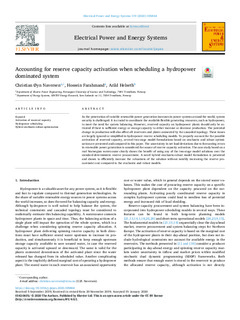| dc.contributor.author | Naversen, Christian Øyn | |
| dc.contributor.author | Farahmand, Hossein | |
| dc.contributor.author | Helseth, Arild | |
| dc.date.accessioned | 2020-02-12T07:09:09Z | |
| dc.date.available | 2020-02-12T07:09:09Z | |
| dc.date.created | 2020-02-11T14:44:02Z | |
| dc.date.issued | 2020 | |
| dc.identifier.citation | International Journal of Electrical Power & Energy Systems. 2020, 119 (105864), | nb_NO |
| dc.identifier.issn | 0142-0615 | |
| dc.identifier.uri | http://hdl.handle.net/11250/2641160 | |
| dc.description.abstract | As the penetration of variable renewable power generation increases in power systems around the world, system security is challenged. It is crucial to coordinate the available flexible generating resources, such as hydropower, to meet the need for system balancing. However, reserved capacity on hydropower plants should only be activated if there is sufficient energy or storage capacity to either increase or decrease production. The potential change in production will also affect all reservoirs and plants connected by the cascaded topology. These issues are largely ignored or simplified in hydropower reserve scheduling models. To properly account for the possible activation of reserved capacity, several two-stage model formulations based on stochastic and robust optimization are presented and compared in this paper. The uncertainty in net load deviations due to forecasting errors in renewable power generation is considered the source of reserve capacity activation. The case study based on a real Norwegian watercourse clearly shows the benefit of using any of the two-stage model solutions over the standard deterministic reserve procurement. A novel hybrid stochastic-robust model formulation is presented and shown to efficiently increase the robustness of the solution without notably increasing the reserve procurement cost compared to the stochastic and robust models. | nb_NO |
| dc.language.iso | eng | nb_NO |
| dc.publisher | Elsevier | nb_NO |
| dc.rights | Navngivelse 4.0 Internasjonal | * |
| dc.rights.uri | http://creativecommons.org/licenses/by/4.0/deed.no | * |
| dc.title | Accounting for reserve capacity activation when scheduling a hydropower dominated system | nb_NO |
| dc.type | Journal article | nb_NO |
| dc.type | Peer reviewed | nb_NO |
| dc.description.version | publishedVersion | nb_NO |
| dc.source.volume | 119 | nb_NO |
| dc.source.journal | International Journal of Electrical Power & Energy Systems | nb_NO |
| dc.identifier.doi | 10.1016/j.ijepes.2020.105864 | |
| dc.identifier.cristin | 1793080 | |
| dc.relation.project | Norges forskningsråd: 268014 | nb_NO |
| dc.description.localcode | Open Access CC-BY | nb_NO |
| cristin.unitcode | 194,63,20,0 | |
| cristin.unitname | Institutt for elkraftteknikk | |
| cristin.ispublished | true | |
| cristin.fulltext | original | |
| cristin.qualitycode | 1 | |

